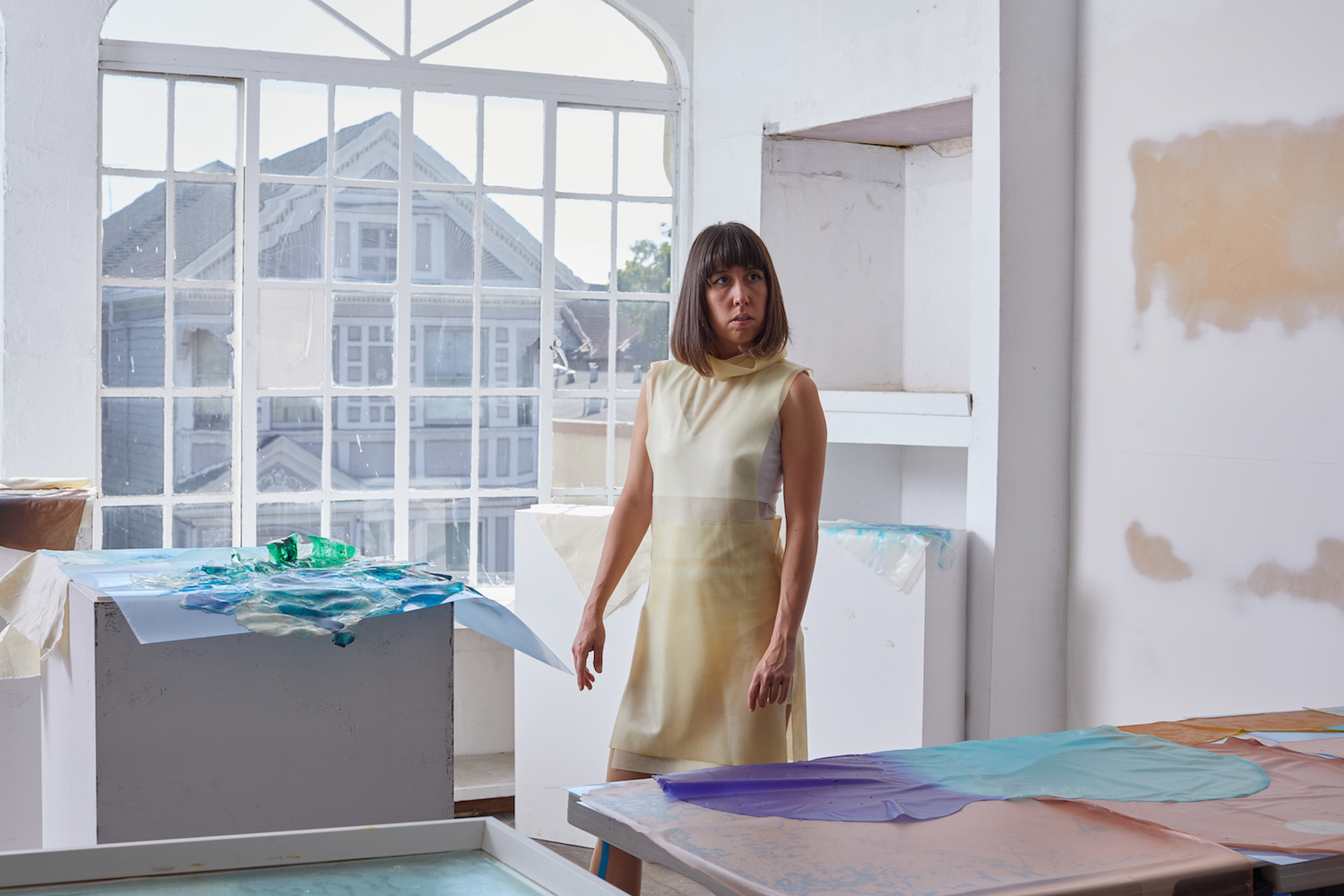As single-use plastics threaten to smother the planet, artist Tiare Ribeaux manufactures a living, breathing alternative.
You probably won’t see artist Tiare Ribeaux walking around town in a color-blocked, oddly gummy coat made of agar-agar. Not because she hasn’t made one—she has, in appealing shades of strawberry and mango that look good enough to eat, in a surreal Fruit Roll-Ups kind of way. It’s just that in the trademark swelter of Oakland, California, where the Honolulu native has lived for most of the last decade, such a garment would simply disintegrate.
“Bioplastics are at the intersection of being alive and not being alive,” Ribeaux says.
A transdisciplinary artist and the founder of new-media gallery and community space B4BEL4B, located in downtown Oakland, she is endlessly fascinated by the potential of bioplastics.
Her work with plant-based materials like gelatin, agar-agar, and tapioca starch is both a statement on, and a possible solution to, the environmental enemy that is petrochemical plastics, roughly 40 percent of which are manufactured to be used only once and destined to languish in landfills.
Through bioplastic molded cuffs and dresses cut from the gelatinous, skin-like materials—so skin-like that if they’re draped over touch screens, hyperlinks will activate—Ribeaux uses fashion as an entry point for her message of environmental sustainability. While a coat can protect you from the weather (other artists and designers are working with chemists to make biotextiles sturdier for everyday use), Ribeaux’s garments and accessories, tinted with natural dyes like hibiscus, turmeric, and volcanic ash, would just plain surrender to it. But maybe that’s the point.
“I really think of biotextiles as provocation,” she says.
Bioplastics are at the intersection of being alive and not being alive.

Ribeaux’s first foray into fashion was in 2009, and in its own whimsical way, was also a form of earthly worship. She designed Fiume, a reclaimed-textile fashion line that took its design cues from the effect of rain on Hawai‘i’s geology. A subsequent stint working as an entry-level technician at Algenol, a Hawai‘i-based developer of biodiesel from algae, eventually led Ribeaux to the intersection of art and science.
Her time with Algenol is clear in another of her ongoing multimedia projects, Cyanovisions, which considers a world in which humans are genetically engineered to have survival traits of the world’s heartiest and most basic organism, cyanobacteria, also known as blue-green algae. But it’s the innovation that biotextiles inspire that really resonates with Ribeaux. To spread the gospel of these quasi-living materials and their potential as alternative plastic, she geared her 2019 project, the Bioplastics Cookbook, toward eco-minded hobby scientists with only a home kitchen in which to experiment.
The artist’s Native Hawaiian heritage makes her uniquely sensitive to an environment at risk. “I feel like I have a special connection to the kind of nature that is lush and alive,” Ribeaux says. She recalls her grandmother’s anecdotes of Waikīkī in its swampy, pre-tourism glory, when 77 degrees was a perfectly balmy daily high—the mercury has risen as development continues to boom. Ribeaux also waxes mournful about the decline of Hawai‘i’s endemic ‘ōhi‘a tree, caused by a foreign fungal disease, and the large chunks of plastiglomerate on Hawai‘i Island’s Kamilo Beach, masses of global plastics, sand, and rock melted together from the heat of bonfires.
The artist contemplates the fate of Pele, the volcano-dwelling Hawaiian goddess who reigns over the land. “What does this plastiglomerate mean for spiritual beings like Pele, and for our native and modern mythologies?” she muses. While the world fawns over Hawai‘i’s headline-making environmental legislation—such as an introduced bill that would ban distribution or provision of single-use plastic bags or beverage containers and prohibit local governments and restaurants from using single-use utensils, stirring sticks, polystyrene to-go containers, and straws—its rich folklore seems less considered. What if, Ribeaux speculates, the unsightly plastic tumors, laden with native sand and volcano rock, were removed?
Would that invoke the wrath of Pele?
Legend has it that the deity curses anyone who takes elements of the sacred land beyond its natural boundaries. In this way, Ribeaux’s bioplastics are much more than degradable textile alternatives—they are an attempt at what she calls a “spiritual remaking in a toxic world.”
“This is why I’ve felt compelled to do work that ultimately leads back to the environment,” Ribeaux says. “I’m really excited about the traction that my bioplastics project has gotten, because it’s going to take a massive shift in perception, as well as a behavioral shift, for things to change in the world.”



